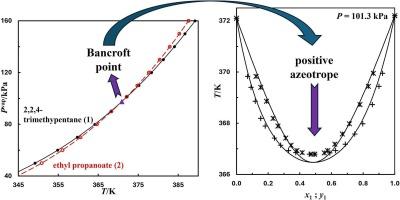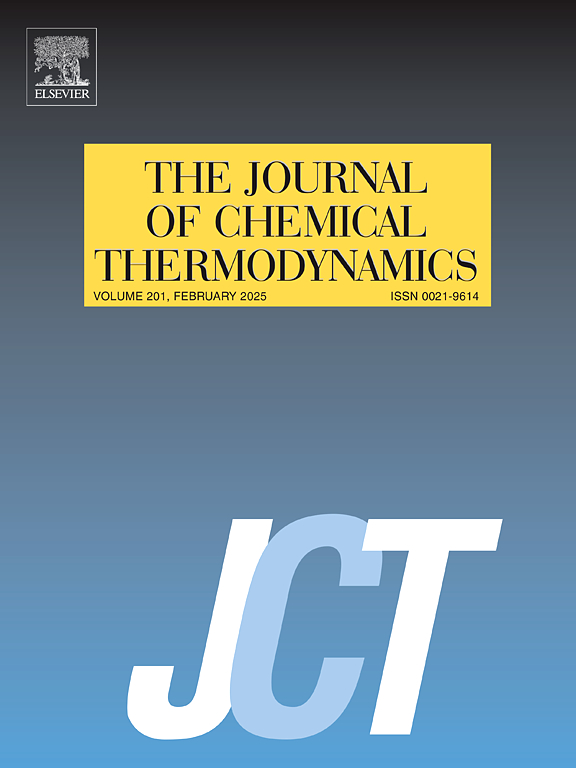2,2,4-三甲基戊烷+丙酸乙酯二元体系:密度、Bancroft点和30,60和101.3 kPa时的汽液平衡
IF 2.2
3区 工程技术
Q3 CHEMISTRY, PHYSICAL
引用次数: 0
摘要
对2,2,4-三甲基戊烷(异辛烷)-乙基乙醇酸二元体系进行了实验研究。在温度T =(288.15, 298.15, 308.15和318.15)k时,用振动管装置测量了混合物的密度。混合物显示出正的过量摩尔体积。在P =(30,60和101.3)kPa的压力下,得到了体系的等压汽液平衡(VLE)。在P = (20 ~ 160) kPa范围内也获得了纯组分的蒸气压。平衡数据使用再循环气泡计(gillespie型VLE池)测量。2,2,4-三甲基戊烷-乙基乙醇酸酯在所研究的压力范围内呈现一个Bancroft点,因此在每个所研究的压力下都具有共沸行为。本文报道了由实测VLE数据导出的共沸坐标。观察到共沸组分对压力有显著的依赖性。使用NRTL和Wilson活度系数模型来关联VLE数据。确定了温度相关的相互作用参数,使报告的VLE数据能够精确关联。预测UNIFAC(多特蒙德)模型也进行了测试。虽然在30千帕时得到了准确的结果,但在更高的压力下发现了明显的偏差。本文章由计算机程序翻译,如有差异,请以英文原文为准。

The 2,2,4-trimethylpentane + ethyl propanoate binary system: density, Bancroft point and vapor–liquid equilibrium at 30, 60 and 101.3 kPa
The 2,2,4-trimethylpentane (isooctane) – ethyl ethanoate binary system was experimentally investigated. The density of the mixture was measured using a vibrating-tube apparatus and is reported at temperatures T = (288.15, 298.15, 308.15 and 318.15) K. The mixture exhibits positive excess molar volumes. Isobaric vapor-liquid equilibrium (VLE) of the system were obtained at three pressures P = (30, 60 and 101.3) kPa. Pure components vapor pressures were also acquired over a range of P = (20 to 160) kPa. Equilibrium data were measured using a recirculation ebulliometer (Gillespie-type VLE cell).
The 2,2,4-trimethylpentane – ethyl ethanoate presents a Bancroft point within the investigated pressure range and, consequently, an azeotropic behavior at each studied pressure. The azeotropic coordinates, derived from the measured VLE data, are reported. A notable dependence of the azeotropic composition on pressure was observed.
The NRTL and Wilson activity coefficient models were used to correlate the VLE data. Temperature-dependent interaction parameters were determined, enabling precise correlation of the reported VLE data. The predictive UNIFAC (Dortmund) model was also tested. While it produced accurate results at 30 kPa, significant deviations were noted at higher pressures.
求助全文
通过发布文献求助,成功后即可免费获取论文全文。
去求助
来源期刊

Journal of Chemical Thermodynamics
工程技术-热力学
CiteScore
5.60
自引率
15.40%
发文量
199
审稿时长
79 days
期刊介绍:
The Journal of Chemical Thermodynamics exists primarily for dissemination of significant new knowledge in experimental equilibrium thermodynamics and transport properties of chemical systems. The defining attributes of The Journal are the quality and relevance of the papers published.
The Journal publishes work relating to gases, liquids, solids, polymers, mixtures, solutions and interfaces. Studies on systems with variability, such as biological or bio-based materials, gas hydrates, among others, will also be considered provided these are well characterized and reproducible where possible. Experimental methods should be described in sufficient detail to allow critical assessment of the accuracy claimed.
Authors are encouraged to provide physical or chemical interpretations of the results. Articles can contain modelling sections providing representations of data or molecular insights into the properties or transformations studied. Theoretical papers on chemical thermodynamics using molecular theory or modelling are also considered.
The Journal welcomes review articles in the field of chemical thermodynamics but prospective authors should first consult one of the Editors concerning the suitability of the proposed review.
Contributions of a routine nature or reporting on uncharacterised materials are not accepted.
 求助内容:
求助内容: 应助结果提醒方式:
应助结果提醒方式:


